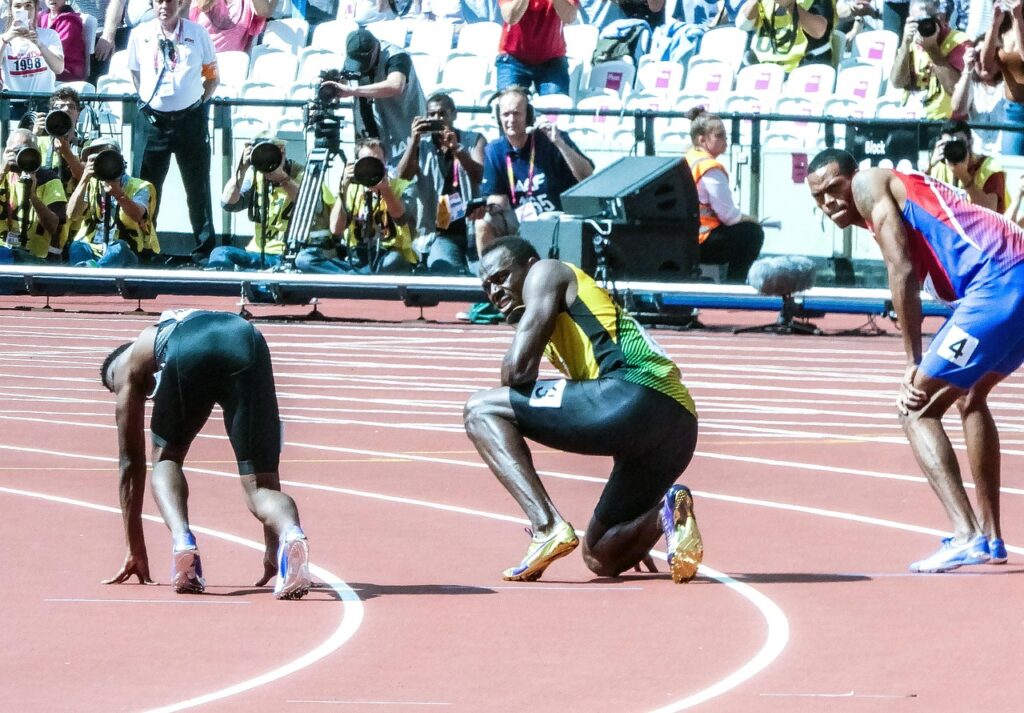The rivalry of red and blue, the iconic yellow and green jackets of victory, even the neon glow of tennis balls – colour and sport are intrinsically linked. Sidelines explores the trivia behind the sporting rainbow!
I was in New York recently, riding the subway, sitting next to a die-hard New York Mets Baseball fan. He was clad in a pinstripe white and blue jersey, ‘Mets’ was proudly scrawled across the front in blue and outlined in a bright orange.
At the next stop, more fans rushed on and more vibrant, orange and blue jerseys emerged.
Growing up in the UK, I was surrounded by sports teams whose colours seemed to fall into just a few familiar palettes.
Manchester United, Arsenal, and Liverpool all proudly wear red, while Chelsea, Leicester City and Manchester City wear various shades of blue.
Colours are so clearly a part of sport, but why do they matter?
Tennis greens and whites
Wearing white is not just a tradition at Wimbledon, it’s a rule. All competitors must be dressed in suitable white tennis attire from the moment they enter the court.
The Wimbledon Championships and ‘tennis whites’ date back to 1877, when white was considered a symbol of elitism and the sight of sweat spots was seen as inappropriate.
Another story of colour within tennis is that the iconic, fuzzy, neon yellow balls we are so familiar with today used to be white. The switch wasn’t merely a fun design choice, it was a solution to a problem.
Wimbledon was the first event in the UK to be broadcast in colour. For the first time, audiences across the country could appreciate the rich green courts and crisp white kits.
One thing they couldn’t appreciate was the ball. David Attenborough, while working as the Controller at BBC Two, found that the white tennis balls were lost on the TV screen.
This led him to advocate for a change of colour and resulted in the vibrant yellow balls of today.

The colour of victory
Every year in July, the Tour de France attracts over 100 of the world’s top cyclists, all competing across thousands of kilometres of harsh terrain. The races are a colourful spectacle packed full of drama and excitement. Through flat countryside sprints and steep inclines, the cyclists battle it out to win one of four iconic coloured jerseys.
The most sought-after prize is the yellow jersey, which is awarded to the race leader, then the green jersey marks the best sprinter. The white and red polka-dot jersey is awarded to the best climber, and finally, the white is awarded to the top young rider (under 26).
As the race progresses, the jerseys switch between different leaders, keeping fans eagerly tuned in.
The other team kits of electric pinks, deep blues and bold greens also contribute to the moving rainbow that snakes its way through France.
Other significant victory colours include the prestigious green of the Masters jacket – a symbol of victory in golf. Sam Snead was the first Masters Champion to be awarded the green jacket in 1949, and it’s a tradition that lives on to this day with Rory Mcllroy proudly donning it the 2025 tournament.
But why is it green?
While the choice of colour can be linked to practicality, as they wanted a jacket that would stand out to visitors of the club, it can also be linked to the location.
Dotted around the Augusta National Golf Club sit a number of azalea bushes which proved to be the perfect colour for the jacket and an homage to the club.
Colours of the courts
The colours beneath an athlete’s feet are also important. Blue has become a dominant choice for modern tennis courts, while athletics tracks typically run red.
Studies show that the bright blue tennis courts were made to improve the visibility of the ball for players, spectators and broadcasters. The optic yellow ball contrasts against the blue backdrop, making it easier to follow.
Red is the most popular colour of athletics tracks as it is UV stable – meaning that it won’t react and fade in the sunlight. Blue and green are also less likely to wear and fade, making them another popular choice.
The 2016 Olympics in Rio were Usain Bolt’s final Olympic games. It was the site of his famous ‘triple triple’ where he won gold medals in the 100m, 200m and 4x100m relay. They were also the first games to include a blue athletics track.

Blue and red rivals
If you look closely at the rival football teams across the UK, you’ll notice a pattern. In many cities and boroughs, the football scene is often split between two dominant sides: one in red and one in blue. It’s a rivalry as old as football itself.
But why these colours?
Historically, colour choices came down to simple practicality. It was about what dye was available and what stood out on muddy pitches.
Over the years these colours have become significant and part of team identities.
This rivalry between red and blue doesn’t just exist on the pitches, it continues in the ring where boxers fight from the red or blue corner.
When Anthony Joshua faced Wladimir Klitschko in a fight that broke attendance records at Wembley Stadium, he was in the blue corner.
Kitschko was a reigning champion with 64 wins and only five losses and this was the reason he stood in the red corner and Joshua in the blue.
The red corner is reserved for the defending champion and more experienced competitor, while the challenger or less experienced fighter is in the blue corner.
Red and blue remain two of the most common but most powerful colours in sport. They are forever entwined and forever rivals.



